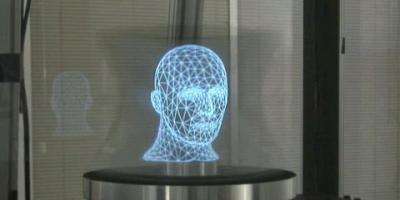November 10, 2008 weblog
3D Display Offers Glimpse of Future Media

(PhysOrg.com) -- The 3D objects in the display box may at first look like a product of smoke-and-mirrors trickery. That impression would be about half right, as a rapidly spinning mirror is one important component of the display.
But the overall 3D display system, developed by researchers at the Graphics Lab at the University of Southern California, is real technology that could one day transform visual entertainment.
The 3D display can project both virtual as well as real images from a recorded movie. The researchers, Professor Paul Debevec and his colleagues, hope that the display´s advantages will overcome many of the challenges faced by 3D technology. For instance, their 3D display is autosterescopic, meaning viewers don´t need to wear special viewing glasses to see the 3D effects. The display is also omnidirectional, so that multiple viewers can watch the display from all directions and heights.
To achieve the high quality, the researchers modified a video projector to project images at more than 4,000 frames per second. Also, the display is interactive, as demonstrated in this video showing a user controlling the 3D human head with a remote control. It can update content at 200 Hz, or 200 times per second.
The video projector projects high-speed video onto the rapidly spinning mirror, and the projector and mirror are synchronized so that, as the mirror turns, it reflects a different image to viewers in all directions.
As the mirror rotates up to 20 times per second, a viewer´s vision creates the illusion of a floating object at the center of the mirror. The image is enclosed in a glass box, to protect anything (such as a hand) from touching the spinning mirrors.
"While flat electronic displays represent a majority of user experiences, it is important to realize that flat surfaces represent only a small portion of our physical world," the team explains on its Web site. "Our real world is made of objects, in all their three-dimensional glory. The next generation of displays will begin to represent the physical world around us, but this progression will not succeed unless it is completely invisible to the user: no special glasses, no fuzzy pictures, and no small viewing zones."
The Graphics Lab has also been involved with creating films, computer animations, and other graphics projects.
More information: 3D Display Research Page
© 2008 PhysOrg.com





















